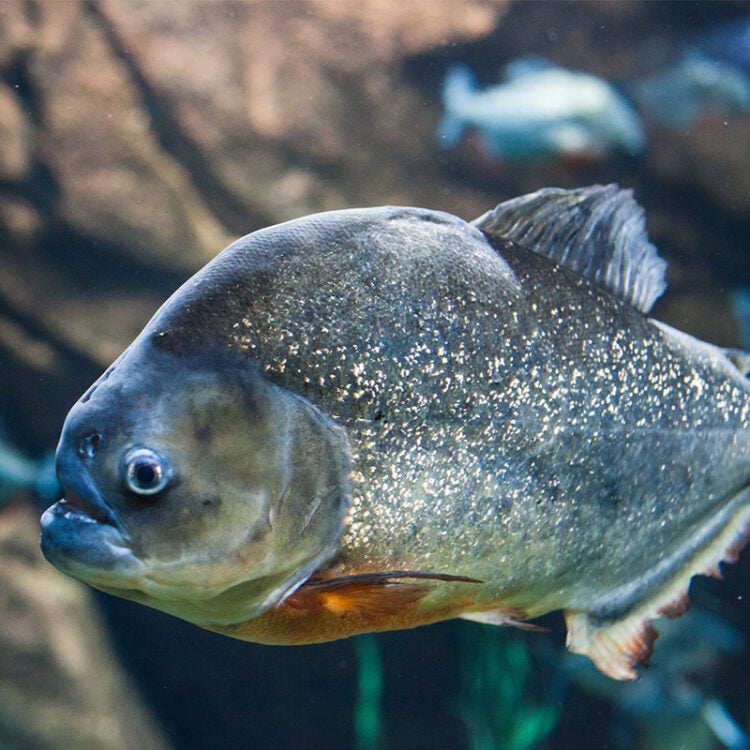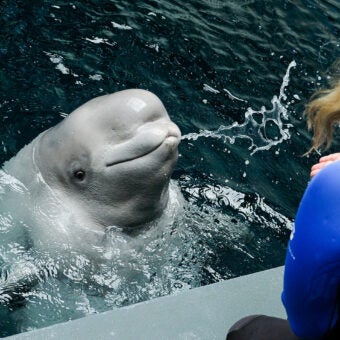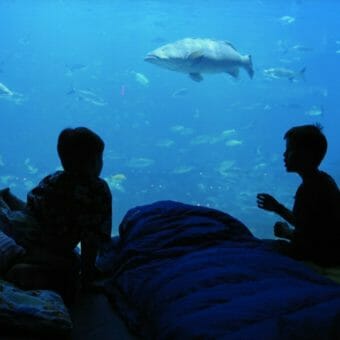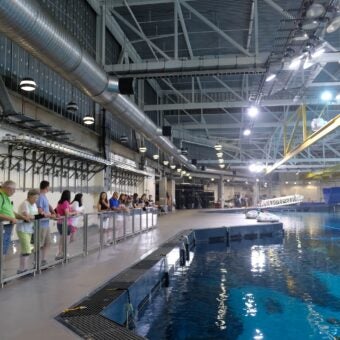-
Size
6-8 inches (15-20 cm) -
Diet
Fish, insects, worms -
Range
South America -
Habitat
Creeks and interconnected ponds
Physical Characteristics
- Male and female red piranhas are very similar in appearance.
- The average length of an adult is 6-8 inches (15-20 cm), although it can grow to 20 inches (51 cm) and 8.5 lbs. (4 kg).
- The stocky body has a reddish belly, though overall coloration varies depending on age and location.
- Other colorations include sides that are often pale brown to slightly olive and backs that are bluish-gray with silver flecks throughout.
- The powerful jaws house sharp, triangular, interlocking teeth.
Animal Fun Fact
Red Piranhas are highly predaceous carnivores that scavenge for food; consuming insects, snails, worms, plants and even nipping the fins of other fishes.
Diet / Feeding
- Feeds communally, with groups of 20 to 30 individuals waiting in vegetation to ambush prey. The prey is attacked en masse. The aggressiveness of the attack is accelerated by the presence of blood in the water.
- This piranha exhibits a “lurking, then dashing” sequence of behaviors during the day.
- This is a highly predaceous carnivore that can also scavenge for food and consume insects, snails, worms, plants, and even nip the fins of other fishes.
- Red piranha can feed continuously and maintains its powerful bite by replacing teeth on alternate sides of the jaw.
- Has been observed to lurk under trees where birds are nesting, waiting for chicks to fall into the water.
Range / Habitat
- Occurs widely in South America in basins of the Amazon, Parana-Paraguay and Essequibo Rivers. Also occurs in coastal rivers of northeastern Brazil.
- Typically found in creeks and interconnected ponds. It prefers areas with dense vegetation.
Reproduction & Growth
- After an elaborate courtship display involving swimming in circles, females deposit layers of eggs on plants in the water and then the male fertilizes them.
- The male guards and fans the egg masses until they hatch in 9-10 days.
- The success of annual reproduction varies depending on the degree to which the flood plain (savannah) is flooded.
Conservation Status
- “Not Evaluated” on the IUCN Red List.
Additional Information
- Preyed upon by crocodilians, fish-eating birds, large mammals (including jaguars), as well as some species of large catfishes.
- A hierarchical structure often exists in small schools.
- Although this is an aquarium fish, some states in the U.S. do not permit red piranha sales, fearing hobbyists may release them into the wild where they could multiply and feed upon indigenous fishes. Incidents of this sort have been reported in Texas, Virginia, Pennsylvania, Oklahoma, Ohio, Minnesota, Michigan, Massachusetts, Hawaii and Florida.
- Although it is not as aggressive as once believed, red piranha can inflict serious bites.
- People living near rivers commonly catch and eat red piranha. Large numbers also are caught to use as bait for large catfishes.
- This species is sometimes called the “red-bellied piranha.”
Sources
- www.fishbase.org
- Grzimek’s Animal Life Encyclopedia, Second Edition, Volume 4: Fishes 1; pg. 346
- www.animaldiversity.ummz.umich.edu







